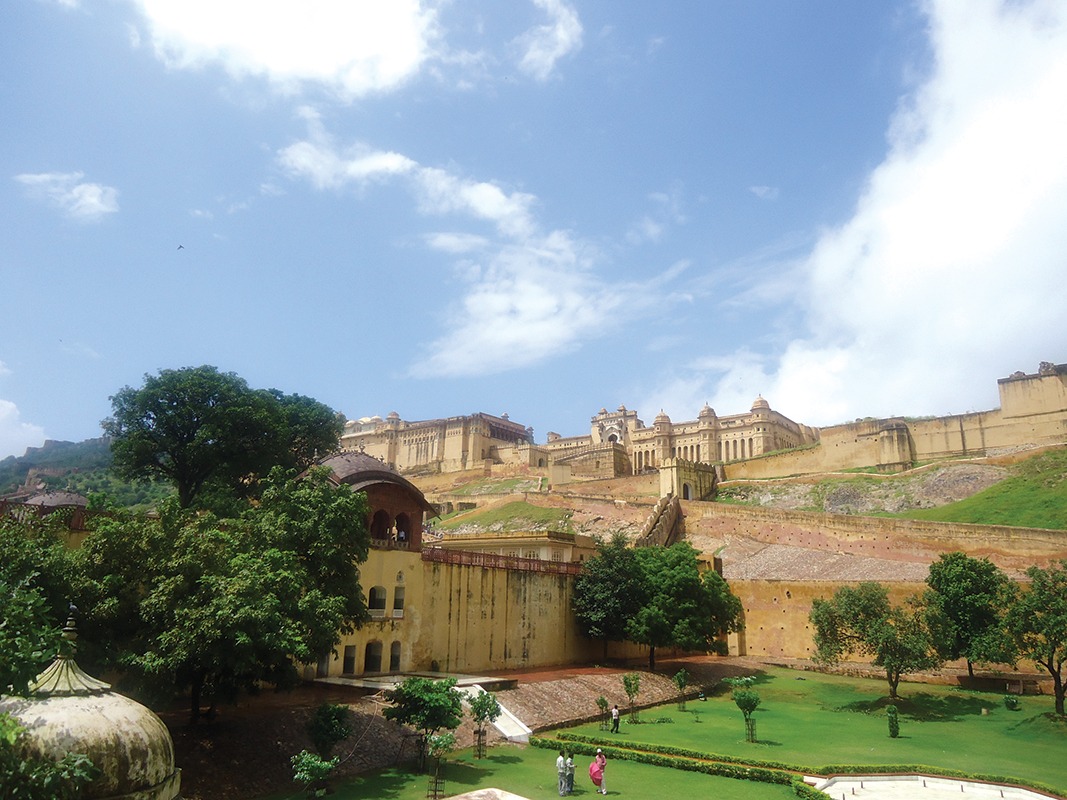Amer
Days of Glory!
By Gigi Dutt
Exotica seldom comes as compactly packaged as Rajasthan. With its fairytale palaces, imposing forts and a topography ranging from the Aravalli Hills, amongst the oldest in the world, and the forbidding sand dunes of Thar Desert to the forested riches of Ranthambore National Park, Rajasthan offers incessant highs and jaw dropping experiences. Jaipur, its capital city, is constantly chaotic yet inherently charming and acquired its ‘blush’ in honour of the Prince of Wales, later King Edward VII, who visited in 1876.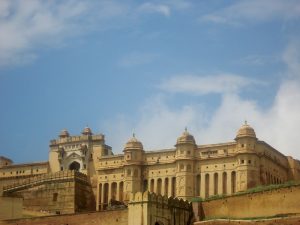
11 km from Jaipur is one of the most magnificent tourist attractions in India: the pink palace-fort above the four square kilometre town of Amer. Amer (or Amber, as it is popularly known) Fort clings to a precipitous, rocky hillside overlooking Maota Lake and was ruled by the Kachwahas from the 11th to the early 18th century, when the capital shifted to Jaipur. A perfect blend of Rajput and Mughal architecture, achieved through a combination of red sandstone and white marble, Amer transports one to an intoxicating past, replete with victory and valour, blood and gore, romance, passion and intrigue and much more. As we approach Suraj Pol or the Sun Gate in pleasurable anticipation, our elephant essays some breath-depriving turns at sharp bends over sheer drops. Our momentary terror vanishes as we admire the sturdy ramparts and enter the Jaleb Chowk or the main courtyard, from which a staircase leads to the main palace grounds and where royal guards paraded and victorious armies flaunted their spoils. We can almost feel those haunting, long-dimmed eyes peeping through the screened windows, in silent celebration of the safe return of their warriors.
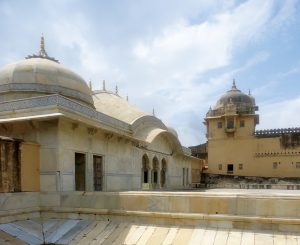
Raja Man Singh, one of Mughal Emperor Akbar’s most trusted courtiers, his Commander in Chief and a member of his Navaratnas, built Amer Fort at the end of the sixteenth century, on the site of a temple dedicated to Amba, built by the Meenas some centuries earlier. We relive those electrifying times as we approach the embossed silver doors of the Sila Devi temple, all legends associated with it and its black stone idol revolving around the defeat of the Raja of Jessore (currently in Bangladesh), at the hands of Raja Man Singh. After keeping at bay our thoughts of the imagined pleas and petitions before the Raja in the grand, colonnaded Diwan-i-Aam, we head for the private quarters of the Maharaja and his family and courtiers through the mosaic and sculpture embellished Ganesh Pol.
A well laid out garden, in typical Mughal style, separates two buildings. On one side is the exquisitely detailed Jai Mandir and the Diwan-i-Khas, meant for private audiences with the ruler, which offers panoramic views. Marble columns and intricate jali work provide a perfect frame for lavishly inlaid panels and a myriad convex mirrors patterned over coloured foil and paint. As the mirror work sparkles like stars in the light of the guide’s single match, our imagination runs riot.
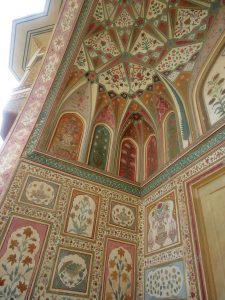 How many romantic trysts did this dazzling Sheesh Mahal witness, as the mirror mosaics glittered like a thousand precious gems in the flickering candle light? Were the lovers doomed? Did they romance their way to eternal fulfillment and bliss? Our pleasurable conjecture is halted as we become aware of the noticeable damage to the intricate workmanship but we are relieved to see restoration work underway.
How many romantic trysts did this dazzling Sheesh Mahal witness, as the mirror mosaics glittered like a thousand precious gems in the flickering candle light? Were the lovers doomed? Did they romance their way to eternal fulfillment and bliss? Our pleasurable conjecture is halted as we become aware of the noticeable damage to the intricate workmanship but we are relieved to see restoration work underway.
Opposite Jai Mandir, is the Sukh Niwas or Sukh Mahal (Hall of Pleasure), which we enter through a sandalwood door intricately inlaid with ivory. A water channel running through this hall would provide a natural air-conditioning system in the midst of that arid heat. We stroll to the Sohag Mandir, with its exquisitely latticed windows and stunning rooftop views, before moving on to the Palace of Man Singh I, which was built over a quarter of a century. The central baradari, a twelve-arched pavilion, opulent frescoes and tiles hint at both Hindu and Mughal influences. This was where the maharanis met to catch up on palace gossip and while away pleasurable hours.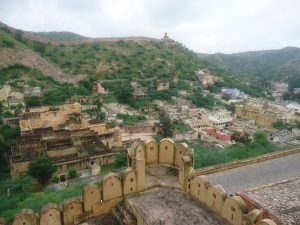
After checking out the ‘magic flower’, a minutely detailed marble fresco carved at the base of a pillar and the Lion Gate leading to the private quarters of the palace, we head towards the world of Amer’s palace for women. The Zenana quarters, where the queens and princesses from the royal family, the concubines and mistresses resided, is a fascinating warren of rooms, passages and staircases.
We delve, with delight, into the palace intrigues of old, when no one quite knew which queen or concubine was being visited by the Raja. Standing there, it is easy to visualise the wiles laid by the women, to ensnare their men and the devious plans of the royal princes to escape detection, as they played out their games of love and bedroom politics – sometimes for the sheer joy of tasting the forbidden fruit of illicit romance and sometimes to decide on the future course of their kingdom.
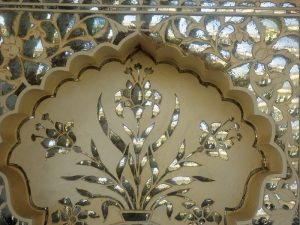 Satiated with the opulent delights served up by the historic monument that is Amer Fort, we head back towards Jaipur, craning our heads to keep that evocative sentinel of time in our vision till the very last bend.
Satiated with the opulent delights served up by the historic monument that is Amer Fort, we head back towards Jaipur, craning our heads to keep that evocative sentinel of time in our vision till the very last bend.
“Raja Man Singh, one of Mughal Emperor Akbar’s most trusted courtiers and a member of his Navaratnas, built Amer Fort at the end of the sixteenth century”
“We delve, with delight, into the palace intrigues of old, when no one quite knew which queen or concubine was being visited by the Raja”
Pics : Babu Sarkar

